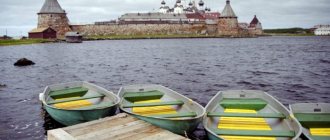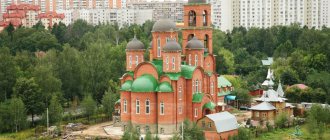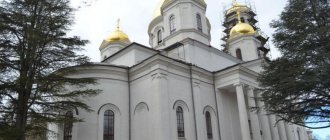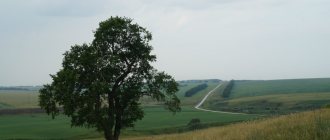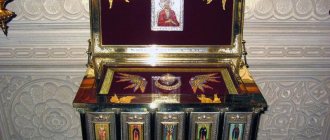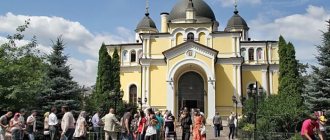List of attractions of the Vladimir region
The list of cultural, historical and religious monuments located in the region is extensive. These include the following:
- Murom Spaso-Preobrazhensky Monastery,
- House-Museum of N. E. Zhukovsky,
- Church of the Intercession on the Nerl,
- St. George's Cathedral in Gus-Khrustalny,
- Church of St. Cosmas and Damian in Murom
- Museum of Wooden Architecture in Suzdal and others.
But if we talk about monasteries in the area that are worth visiting, pay attention to these:
- Svyato-Vvedensky Island,
- Holy Dormition princess female,
- Holy Bogolyubsky Women's,
- Holy Trinity Women's.
We will tell you more about them below.
Church of the Transfiguration, Alexandrov
It was built by order of Elizabeth Petrovna in 1742 as a cold church next to the wooden Borisoglebskaya and was named in the name of the holy righteous Zechariah and Elizabeth; in 1790-95 expanded by adding a refectory to the southern aisle and enlarging the altar apse. Renamed in memory of the Transfiguration of the Lord in 1804, the church was supplemented with a 65 m high bell tower, which has not survived to this day.
The refectory of the temple had chapels: the Holy Saints Zechariah and Elizabeth and in the name of the Celebration of the Epiphany of the Lord.
The church was closed in the 1930s, the bell tower was dismantled. The temple is currently undergoing restoration.
In its original basis, it belongs to the type of tiered octagon-on-quadruple temples in the traditions of the Naryshkin style (Moscow baroque). Reconstructions at the end of the 18th century. stylistic ones belong to the transition period from Baroque to Classicism.
Holy Vvedensky Island Monastery
Now the Intercession of the Holy Vvedenskaya Island Hermitage is intended for women, but originally it was for men. What makes it island-like is its location on the island of Lake Vvedenskoye. At the end of the 17th century, the monks Sergius and Timofey retired here and erected wooden chapels and cells for their needs. However, the elders did not manage to live in solitude for long, since there were many potential inhabitants of their desert. By the beginning of the next century, the elders asked for blessings to build their own church, originally wooden.
The Golitsyn princes, who owned the island, donated to the monks not only lands, but also fisheries. Under Paul I, the monastery also received hay fields and a mill. From Princess Prozorovskaya the monks received 20 acres of land on the lake shore.
The monastery was closed by Soviet authorities in 1918. The territory was given to a home for the elderly and disabled, then an orphanage settled there. Since 1932, a women's colony for teenage girls was opened within the walls of the ancient desert. In 1940, the reconstruction of buildings began: domes were cut down, a school, a club and a cinema hall were placed in the churches.
The monastery buildings were returned to the Church in the 1994s. Legend has it that the future abbess Fevronya asked the director of the correctional institution V.S. Karpenko to serve a prayer service in the former church. The director said that he would transfer St. Nicholas Church to the monastery at the insistence of a certain “gray-haired old man” who appeared to him in a dream. The first service took place in 1995 on Christmas Day.
The monastery operates a gold-embroidery workshop, nuns make church utensils and restore icons. There is a boarding house for unattended teenagers.
Address: Petushinsky district, Pokrov, p/o Vvedenskoye.
Phone: 8 (49243) 6-31-36.
The most ancient monasteries of the city of Vladimir
Local historian and researcher of Vladimir architecture Tatyana Timofeeva has published a new book dedicated to the history of Vladimir monasteries. The study brings together for the first time the basic data on the Nativity, Constantine-Elenin and Fedorov monasteries.
Lovers of Vladimir history have long had a need for such a comprehensive study. There is only one book about the Nativity Monastery by Konstantin Tikhonravov, published in 1869 and republished in 1997. Until now, only separate articles have existed about the Konstantin-Eleninsky monastery in the village of Dobroye and the Fedorovsky monastery, which stood near the village of Krasnoye, most of which were also written by Tatyana Timofeeva.
The Nativity Monastery, the author of the study admits, has passed through her entire life. Timofeeva first became acquainted with the monastery as a child, when the Vladimir department of the KGB of the USSR was located there.
“My first acquaintance with the monastery took place in childhood. Dad, Colonel Timofeev, worked as a political officer at the Ministry of Internal Affairs school. When I was 6 years old and my brother was 7, we were sent to the Lesnoy Gorodok pioneer camp in Penkino. The departure was scheduled from the monastery, which belonged to this department. What remains in my memory is the deserted dusty square and the long, tedious wait for the bus.
Later, when I was 10 years old, my dad was in the hospital, which was located in the northeastern building of the monastery, the oldest - 1654. They entered through a low door, put on white coats, then walked along the stairs to the right, into the depths of the building. The rooms were located at different heights, there were steps between them,” recalls Tatyana Timofeeva
.
Working in the architectural department of the Vladimir-Suzdal Museum-Reserve, Timofeeva was involved in various aspects of the history of the monastery. In particular, she studied the fate of the monastery’s main cathedral, the Nativity Cathedral, which was demolished during the years of Soviet power.
“The fate of the cathedral was decided by a letter from the head of the local branch of the GPU named Muzykant. In July 1930, it was dismantled to the ground - they did not blow it up, as building material was needed. There are poems about the closing of the cathedral:
Where peacocks walked, there the Cheka marches. In the ancient monastery church the door is closed - you can’t remove the lock.
The treasurer and other brethren are driven to a strange house. God and the Red Army army cannot get along in a holy place,”
— the author spoke at the book presentation
.
Timofeeva had to deal with the stone “tomb of Prince Alexander Nevsky” stored in the museum. In the early 1990s, it lay at the entrance to the historical museum, and later was transferred to the Nativity Monastery at the request of Metropolitan Evlogy. Timofeev wanted to understand whose tomb it really was - it was too small for the prince-hero Alexander Nevsky, as the Laurentian Chronicle represents him. During the research, it turned out that in 1930, during the demolition of the Nativity Cathedral, four stone tombs, including those with human remains, were discovered at a depth of 3 meters. One of them was transferred to the museum. It was not possible to find out exactly whose tomb this was, but the data convincingly showed that it could hardly have been the resting place of Alexander Nevsky.
In her new book, Timofeeva examines in detail the question of the date of the foundation of the Nativity Cathedral and the founding of the monastery. The researcher claims that the temple was built from 1191 to 1196, and at that time the monastery did not yet exist. According to the historian, the time of establishment of the monastery can be considered the interval between 1196 and 1206.
The status of the monastery was very high until the 18th century. From the middle of the 13th to the beginning of the 14th centuries, Russian metropolitans stayed in the monastery. Until 1723, the relics of Alexander Nevsky were kept here.
“Until the middle of the 16th century, the monastery was considered the first among Russian monasteries. In 1561, by a charter from Metropolitan Macarius, at the will of Tsar Ivan Vasilyevich, primacy among Russian monasteries was transferred to the Trinity-Sergius Monastery... In 1720, the monastery lost second place to the Alexander Nevsky Monastery and began to be considered third. However, even after this, the Nativity Monastery was sometimes called a monastery,” writes Tatyana Timofeeva
.
In the middle of the 18th century, there were 35 inhabitants in the monastery. In 1744, in connection with the formation of the Vladimir diocese, the monastery was converted into a bishop's house. Since 1788, the bishop lived in Suzdal, but in 1798 he returned to Vladimir.
“Before the establishment of the Bishop’s House, the Nativity Monastery probably occupied a smaller territory than subsequently. The western part behind the building of the Bishop's House, occupied by a garden, in ancient times belonged to the posad or, rather, to the parish St. Nicholas-Kremlin church. Archaeological investigations discovered a cemetery at this place,” Timofeeva points out
.
Several chapters of the book are devoted to the main cathedral of the monastery. In particular, Timofeeva says that the temple in the 17th-18th centuries had five domes and describes its numerous extensions. Drawings of the cathedral from 1858 and photographs of the surviving carved stones of its facades are provided. Separately, the author of the book dwells on the reconstruction of the dilapidated monument in the 1860s, when it acquired the appearance of an ancient white-stone temple.
The book provides a description of other little-known ancient monastery churches that existed in the monastery: the Trinity refectory (Christ's Nativity), the gate church of Alexander Nevsky, St. John the Baptist Church, the church of the holy martyrs Photius and Anicetas. Separate chapters are devoted to the hipped cathedral bell tower of the 17th century, on which there was a striking clock, as well as monastery buildings before the 18th century and buildings of the bishop's period.
Timofeeva dwells in detail on the fence of the monastery, its gates and towers. At the beginning of the 18th century, the walls of the Nativity Monastery in the city of Vladimir and four gates were wooden. The eastern gate, according to legend, was tightly closed after the relics of Alexander Nevsky were removed from the monastery. In 1763, the entire fence of the monastery was already made of stone with 4 gates and 4 corner towers. The southern gate facing Klyazma was also tightly sealed since the mid-19th century and was not used.
The chapter dedicated to the monastery necropolis provides all the known facts about the burial of Alexander Nevsky and the tombs found in the Nativity Monastery in the 1930s and 1990s. Timofeeva reports that archimandrites, archbishops, monks, cathedral elders, retired military men sent to the monastery by royal decree “for food” were buried in the monastery.
In a separate chapter we talk about the courtyards and courtyards of the monastery and the bishop's house - about the "monastery settlements" in Vladimir, about the guest courtyard outside the Ivanovo Gate, about the bishop's summer house near the Assumption Cathedral, about the Patriarchal Garden, about country courtyards: near Verizino on the Sodyshka River , on the Rpen River, in the village of Dobroy, about farmsteads in the Suzdal Kremlin, in the Moscow Kremlin and other places in Moscow.
In the appendix called “The Word of Destruction” of the Nativity Cathedral. Documentary Chronicle,” describes in detail what happened to the monastery after the October Revolution - how in 1918 internal security troops entered it to serve the needs of the provincial department of the Cheka, how the monks were evicted, how a dance hall was opened in the Cross Church, how the residents of Vladimir tried to save the Nativity Cathedral and the bell tower from demolition and how in 1925 part of the monastery wall was almost demolished.
The second section of the book is devoted to the Constantine-Eleninsky Monastery in the village of Dobroye. The author analyzes various existing dating dates for its origin, including the legend about the founding of the monastery under Andrei Bogolyubsky, describes historical acts and charters associated with the monastery, including the textbook charter of Metropolitan Cyprian in 1391, talks about its abolition in the 18th century and the sad fate of the monks .
“After the “tertiary” decree, in August 1776, the monks left their flourishing monastery and moved to the dilapidated Volosov (the modern village of Nebyloye, Yuryev-Polsky district, - author’s note), while the name “Tsarekonstantinov” passed to the Volosov Monastery. For a long time, the settlers could not come to terms with their fate and longed for their former monastery,” writes Timofeeva
.
Tatyana Timofeeva describes all the preserved and non-preserved buildings of the Constantine-Elenin monastery.
In the section about the now defunct Fedorovsky Monastery, the author of the book summarizes all the limited information about this monastery. The monastery stood northeast of Vladimir, on a hill near the confluence of the Rpen and Pochaika rivers, next to the so-called Yarilova Valley. The monastery could have been founded under Andrei Bogolyubsky.
“The reason for this is considered to be the miraculous salvation of the prince on the day of the holy martyr Theodore during the battle for the city of Lutsk as part of the squad of Yuri Dolgoruky,” writes Timofeeva
.
According to another version, the monastery was founded by the first bishop Theodore in the 10th century, simultaneously with the founding of the city of Vladimir by Prince Vladimir the Saint.
The Fedorovsky Monastery is mentioned in documents from the mid-17th century and is present in Vladimir’s drawing of 1715. However, judging by the sources, after the Lithuanian devastation the monastery was greatly abandoned, its lands were taken over by neighboring landowners and peasants.
In 1682, the monastery was assigned to the Nativity Monastery, and in 1798 it was abolished. In the 19th century, only ancient bricks, mica, white tombstones with inscriptions, and clay vessels were found on the site of the Fedorovsky Monastery. At that time there was still a holy spring, found, according to legend, by the first inhabitants of the monastery. And for a long time people called this place Fedorovsky Meadow.
The book “Vladimir Monasteries” by Tatyana Timofeeva was published in St. Petersburg in a circulation of 300 copies. It presents 94 illustrations, some of them are published for the first time. You can purchase the publication only via the Internet, and you can familiarize yourself with the book in the Vladimir Regional Scientific Library, of course, after the “coronavirus restrictions” are lifted.
Holy Dormition Princess Convent
The ancient monastery was founded around 1200 by Grand Duke Vsevolod the Big Nest. The prince was persuaded by his wife Maria Shvarnovna, hence the name. Several grand duchesses are buried here, including the founder.
The monastery was repeatedly ravaged and suffered from fires. It was closed in 1923 and reopened only 70 years later. Currently there is a regency school here, and there is also a farmstead in the village of Sanino.
Address: Vladimir, st. Knyaginin Monastery, 37a.
Telephone.
Church of the Bogolyubskaya Icon of the Mother of God, Alexandrov
Construction of the brick church and bell tower at the city cemetery was completed in 1800; the chapels at the refectory - the Great Martyr Theodore Stratelates and the Great Martyr Barbara - were built in 1829 by order of the Alexandrov merchants A.M. Kalenova and F. Baranov.
In the 1930s The bell tower, rebuilt at the beginning of the 21st century, has been lost.
An interesting example of a temple in the style of mature classicism with individual pseudo-Gothic motifs. The decor of the facades is very restrained; only pilasters and half-columns at the edges of the ends, smooth friezes at the end of the walls and lancet windows stand out.
Holy Bogolyubsky Convent
There are suggestions that the structure may date back to the beginning of the 13th century, but information about how this monastery was founded and first developed is extremely scarce. It is noteworthy that the building originally belonged to the palace of Andrei Bogolyubsky. This is the only civil structure that has survived from pre-Mongol times to the present day, albeit not completely. Another feature of the monastery is that the place where the prince was supposedly killed has remained here to this day.
The Holy Bogolyubskaya monastery is also worth visiting because a procession of the cross is now taking place there again, according to a tradition dating back to the 18th century. You can see it on July 1, since this day marks the annual feast of the Bogolyubskaya Icon of the Mother of God.
Address: pos. Bogolyubovo, Suzdal district, st. Lenina, 51V.
Telephone.
Cathedral of the Nativity, Alexandrov
In 1627, on the site where the Nativity Cathedral now stands, there were two wooden churches - the Nativity of Christ and St. Nicholas the Wonderworker. In 1696, instead of two wooden churches on Tsarskaya Gorka, a stone Church of the Nativity of Christ with a chapel of St. Nicholas of Myra was built. In 1825, by order of the mayor I. Nikitin and the merchant N. Kalenov, peasants E. Borisov and L. Dmitriev erected a new bell tower. In 1847, funded by local manufacturer I.F. The Baranova temple was built with a second tier and the refectory was expanded. There are two chapels in the refectory of the cathedral: St. Nicholas and St. Michael the Archangel. The two-story almshouse building, located north of the church, on the opposite side of Cathedral Square, was built in the 3rd quarter of the 19th century, at the same time a one-story guardhouse appeared at the southern facade of the cathedral.
At the end of the 1920s, the temple was closed. The bell tower and the end of the temple were dismantled. In 1992, the temple was opened to believers. Since 2013 - the Cathedral of the Alexander Diocese.
A monumental structure with an original three-dimensional composition, erected on the basis of a temple of the late 17th century, received as a result of reconstructions in the 19th century. a unique appearance that combines features of late classicism and Russian-Byzantine style. From the original cathedral, erected in 1696, the lower tier of the quadrangle and the apse have been preserved.
Church of the Holy Princes Boris and Gleb, p. Volokhovo
In 1699, on the site where the temple stands, there was an ancient wooden church. According to legend, there was a monastery here, burned by the Poles in 1609. In 1805-15. at the expense of landowner A.A. Baskakov the existing temple was built. In the refectory there were limits: Metropolitan Alexy and Great Martyr Barbara.
Closed in the 1930s. Since 2006, the temple has been open to believers. Currently, the courtyard of the Smolensk Zosimova Hermitage. The temple is being restored. One of the most striking examples in the region of a manor church in the style of mature classicism; architectural features suggest the participation in its creation of Moscow architects from the circle of M.F. Kazakova. Fragments of oil painting from the 2nd half of the 19th century have been preserved. https://www.hram-volohovo.ru/
Church of the Presentation of the Blessed Virgin Mary into the Temple, p. Irkovo
The church in the village has been known since 1692. The current stone church and bell tower were built in 1867 -1880. In the 1930s the temple was closed. The refectory with the Nikolsky chapel and the low hipped bell tower were dismantled in 1969. Opened in the late 1990s.
An ordinary rural church of the eclectic era, built in the Russian style. The decoration of the side facades is dominated by generalized Old Russian details, fastened with classicist cornices: paneled blades, platbands, groups of three kokoshniks in an attic belt.
Church of St. Seraphim of Sarov, Alexandrov
The temple was built in 1904 and was one of the first in Russia consecrated in the name of the great Russian saint Seraphim of Sarov, canonized in 1903. In 1910, the temple was painted in the Byzantine style. Closed in 1928, completely rebuilt.
On August 1, 2003, a chapel with the same name was erected near the temple. Since 2007 it has been open to believers.
The temple was built in the Russian style with a high pyramidal roof topped with a dome and a gilded cross. The bells hung on the belfry on the northern, outer wall of the temple. The corner pilasters of the main volume of the temple were decorated with wonderful polychrome tiles. https://www.xramserafima.ru/
Church of the Apostle and Evangelist John the Theologian, p. Afanasyevo
The wooden church in the village has been known since 1628. Construction of the current Church of St. John the Evangelist was completed in 1802; the brick walls were painted white and red. The chapel in the refectory is consecrated in the name of St. Nicholas the Wonderworker.
In 1870-1875 at the expense of landowner N.P. Stromilov, a bell tower was erected, the temple was surrounded by a stone fence.
The church was closed in the 1930s, the bell tower was dismantled in 1964. Since 1999 it has been open to believers.
The composition of volumes, two-tone coloring and decoration with baroque reminiscences are characteristic of early classicism.
Church of the Tikhvin Icon of the Mother of God, p. Ryuminskoe
The stone temple was built in 1806-1808. at the expense of the landowners Shubins, owners of the village. Ryuminskoe, at the same time a stone bell tower was erected. In the refectory of the temple there were two chapels: the Unmercenary Cosma and Damian and St. Nicholas the Wonderworker. In 1843, the temple was plastered and painted. In 1871, with funds from A.Ya. Bochenkova made new iconostases. In 1884, a parish school was opened at the church.
Closed in the 1950s, the bell tower was dismantled. The restoration of the temple began in 2007.
The composition of the temple of the rotunda (round) type on a quadrangle and the decor of the facades are characteristic of the architectural forms of mature classicism. Oil paintings from the late 19th century have been preserved in the temple.
